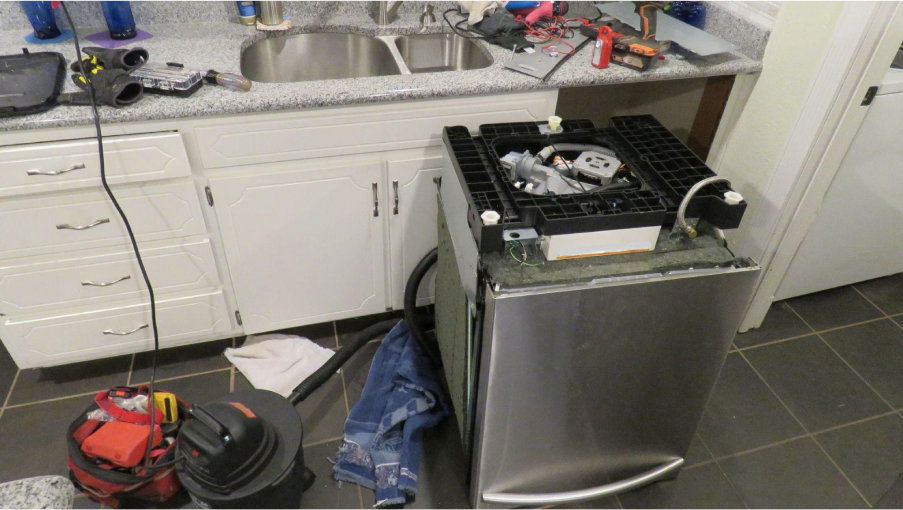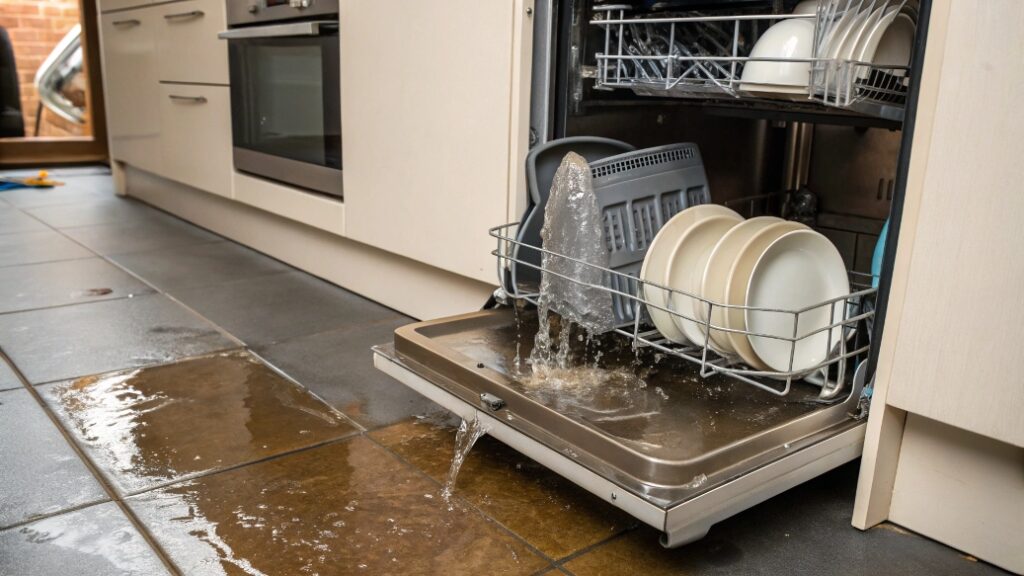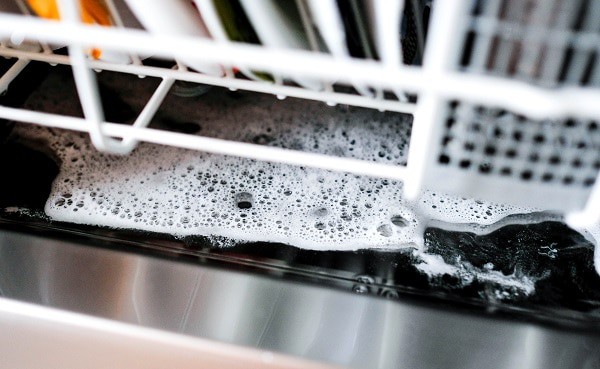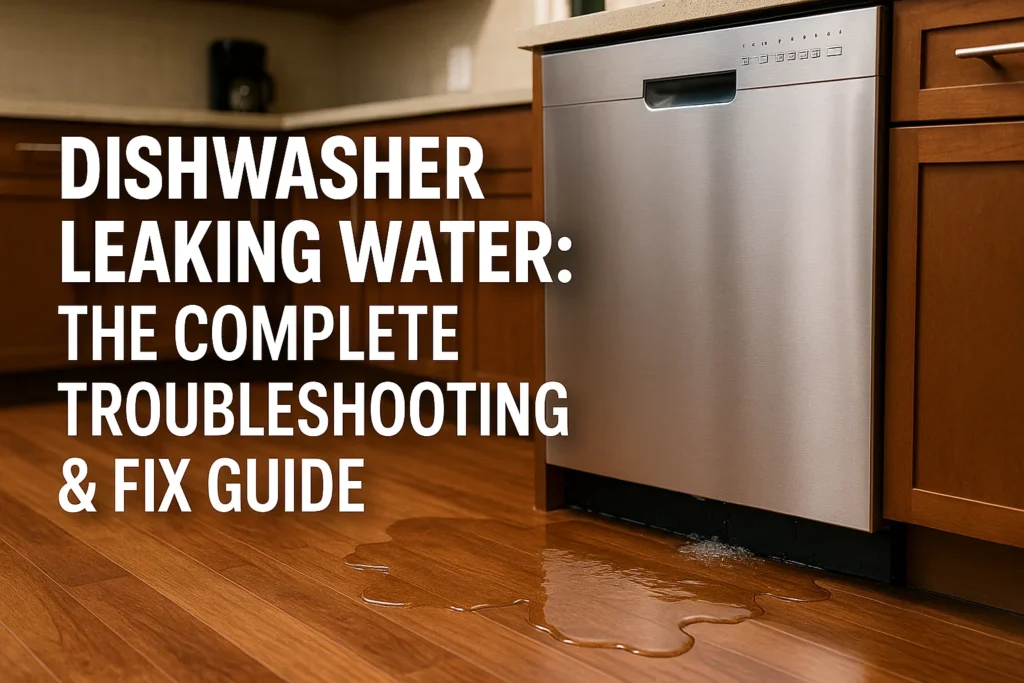If you’ve spotted a puddle beneath your dishwasher—or a slow, irritating drip from the door—you’re not alone. Leaks are among the most common dishwasher headaches, and the causes range from simple (a tired door gasket or too much suds) to mechanical issues like a seeping inlet valve or a worn pump seal. The good news: with a few quick checks and some basic tools, you can usually pinpoint the source in minutes.
In a rush? If water is pooling on the floor, shut the dishwasher off, grab towels, and skim this quick map. If you’re in NYC and want a fast professional fix, book a dishwasher repair in New York.
| Symptom / Error | Likely Causes | DIY Fix | When to Call a Pro |
|---|---|---|---|
| Door Bottom — drips from bottom of door | Dirty/flattened door gasket; Misaligned latch; Over-sudsing (wrong detergent); Unit not level | Clean door channel and gasket; replace if brittle/cracked. Adjust latch for even seal. Use dishwasher detergent only. Re-level front feet. | If leak persists after new gasket/latch or door edge is corroded/warped. |
| Underneath — water pooling under unit | Loose/damaged supply line; Seeping inlet valve; Leaking pump or seal; Cracked tub | Tighten fittings; replace washers/line; inspect valve for mineral crust; check pump for drip trail. | Pump/seal replacement or confirming cracked tub. |
| Not Running — leak even when off | Inlet valve stuck slightly open; Supply connection drip; Standing water from clogged filter | Shut off water; watch for fresh droplets at valve; clean filter & sump; leave door ajar and recheck. | If a new inlet valve doesn’t stop slow fill/drip. |
| Fill Phase — leaks early in cycle | Stuck float/float switch; Overfill from inlet valve; Unit not level | Ensure float moves freely and clicks; clean debris; test/replace inlet valve; level cabinet. | Electrical testing for float switch/control issues. |
| Drain Phase — leaks during drain/end | Clogged filter/sump; Kinked/cracked drain hose; Blocked air gap or disposal knockout | Remove & rinse filter; wipe sump; straighten/replace hose; clear air gap; confirm knockout removed. | If backups recur after full cleaning and hose replacement. |
| Front Corners — streaks or occasional drips | Debris in door channel; Tall items deflecting spray arm; Overloaded racks | Wipe channel; reposition tall pans so lower spray arm spins freely; balance load. | If corners still leak with new gasket and proper loading. |
| Error/Lockout — anti-flood/leak sensor triggered | Water in base pan; Drip from hose/pump onto sensor | Unplug power; remove toe-kick; dry base pan; run short cycle while observing; replace cracked hoses/clamps. | If sensor keeps tripping or there’s electrical moisture damage. |
Safety First
- Cut power & water. Turn off the dishwasher at the breaker and close the water supply valve under the sink.
- Protect flooring. Lay down towels or a tray to catch drips; set a small fan to dry the area.
- Document damage. Photos and short notes help if you need to file an insurance claim.
Tools you’ll likely need: towels, flashlight, screwdriver set, adjustable wrench, needle-nose pliers, multimeter (optional), and replacement parts like a door gasket or hose if needed.

How to Locate the Leak (5-Minute Flow)
Run a short cycle (or a rinse) and watch these checkpoints in order:
- Front of the door – Look for drips or streaks at the lower corners.
- Under the door/kick plate – Remove the toe panel and check for splash marks.
- Back left/right – Inspect the supply line and inlet valve connections.
- Center underside – Check the pump body, pump seal, and nearby tub seams.
- Drain path – Examine the filter, sump, drain hose, and air gap (or garbage disposal port).
Tip: If the leak appears only during fill, suspect the float or inlet valve. If it appears during drain, look at the filter/sump and drain hose.
Whirlpool +1 Causes & Fixes by Symptom
A) Leaking From the Bottom of the Door
Likely causes: dirty or flattened door gasket, misaligned door latch, over-sudsing (wrong detergent), overloading, or machine not level.
Fixes:
- Clean the gasket and door channel; replace gasket if cracked or compressed.
- Adjust the latch so the door closes evenly.
- Use dishwasher-specific detergent only; avoid too much rinse aid.
- Relevel the front legs so the tub sits square; confirm with a small bubble level.
B) Leaking Underneath the Unit
Likely causes: loose/damaged water supply line, faulty inlet valve, dripping pump or pump seal, or a cracked tub.
Fixes:
- Tighten or replace the braided supply line; use new washers.
- Inspect the inlet valve for mineral buildup or seepage; replace if it won’t fully close.
- Look for a drip trail from the pump; a new seal (or pump) may be required.
- If the tub is cracked, weigh repair vs. replacement (see below).
C) Leaking When Not Running
Likely causes: a seeping inlet valve, slow supply connection drip, or leftover standing water from a clogged filter/drain that overflows later.
Fixes:
- Shut the water off; monitor the inlet valve area for fresh droplets.
- Reseat and tighten compression fittings.
- Clean the filter and drain path thoroughly; leave the door ajar overnight and recheck.
D) Leaking During Fill or Early in the Cycle
Likely causes: stuck or misreading float/float switch, overfill from inlet valve, or unit not level.
Fixes:
- Lift and drop the float—should move freely and click; clean debris under it.
- Test and replace a sticky inlet valve.
- Relevel the machine to manufacturer spec.
E) Leaking During Drain / End of Cycle
Likely causes: clogged filter/sump, kinked or cracked drain hose, blocked air gap or garbage disposal knockout still in place.
Fixes:
- Remove, rinse, and reinstall the filter; wipe the sump.
- Straighten or replace the drain hose; secure with proper clamps.
- Clear the air gap; if recently installed to a disposal, ensure the knockout plug was removed.Component-Level Guides (Skimmable How-Tos)

Door gasket (10–20 min).
Open the door and inspect corners first—they fail early. If the gasket is brittle or flattened, pull it out gently, clean the channel, warm the new gasket in hot water to relax it, then press in from the center outward.
Water inlet valve (20–40 min).
Unplug power, shut water. Remove toe panel, locate valve, and check for mineral crust or a slow bead of water. Replace if it won’t seal; always use fresh Teflon tape and correct fittings.
Pump & pump seal (30–60+ min).
Look for a drip path at the center base. If the seal is weeping, you’ll often see a chalky ring where water dries. Replacing the seal or pump is straightforward but may require tilting or removing the unit.
Supply line & fittings (10–25 min).
Braided stainless lines resist bursts better than vinyl. Replace crushed washers, avoid overtightening, and support the line to prevent vibration.
Filter & sump cleaning (5–10 min).
Twist out the filter, rinse under warm water, toothbrush the mesh, and wipe the sump cavity. Monthly cleaning prevents drain-time overflows.
In the middle of the job and need an expert eye? A local dishwasher technician in NYC can diagnose leaks quickly and stock common parts.
Brand-Specific Notes (If Applicable)
Bosch.
Check for leak-related error behavior (e.g., anti-flood triggering). Ensure side channels are clear and that the base pan isn’t holding water—some models have sensors that shut things down when they detect moisture.
Whirlpool/Maytag.
Frequent culprits include the door gasket corners, diverter/pump seal at the center underside, and inlet valves with mineral buildup. Leveling makes a bigger difference on these than most people expect.
When to Repair vs. Replace
Consider the age (around 10+ years), frequency of leaks, and the cost of major parts like pumps or tubs. A practical rule: if the repair would cost more than ~50% of a comparable new unit—and your machine is older—replacement begins to make sense. Also think about hidden costs: water damage risk and your time.
Prevention Checklist (Monthly/Quarterly)
- Clean filter and spray arms.
- Check gasket elasticity; wipe debris from the door channel.
- Verify leveling front-to-back and side-to-side.
- Inspect supply and drain hoses for wear or rubbing.
- Use proper detergent (no regular dish soap) and don’t overfill dispensers.
- Load properly: keep tall items from deflecting the lower spray arm.

FAQ
Why is my dishwasher leaking from the bottom of the door?
Usually a compromised door gasket, misaligned latch, or over-sudsing. Clean/replace the gasket and confirm the door closes evenly.
Can a dishwasher leak when it’s not running?
Yes—an inlet valve can seep and slowly fill the tub; fittings can also drip. Shut off the water and monitor for fresh droplets.
How do I know if the inlet valve is leaking?
With water on and power off, check the valve outlet for a slow bead forming. Mineral crust or dampness at the body is another giveaway.
Will a clogged filter cause a dishwasher leak?
It can. A blocked filter/sump restricts flow and may cause drain-time overflow or backwash at the door.
Is it safe to use my dishwasher if it’s leaking a little?
No. Even small leaks can damage cabinetry and subflooring, and some leaks reach live components. Fix first, then run.
How do I stop a dishwasher from leaking underneath?
Tighten or replace the supply line, test the inlet valve, inspect the pump seal, and look for cracks in hoses or the tub.
What detergent issues can cause leaks?
Using non-dishwasher soap or too much detergent creates excess suds that push water past the door seal.
When should I call a professional vs. DIY?
If you see a cracked tub, persistent pump seal leaks, electrical faults, repeated leaks after DIY fixes, or you simply want a guaranteed repair, bring in a pro.
